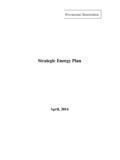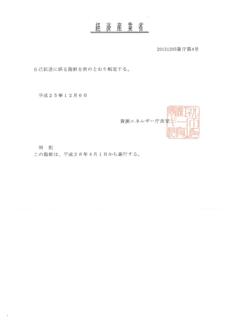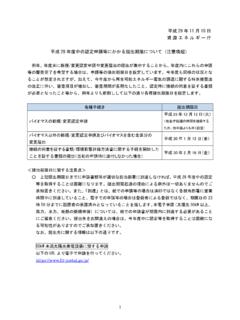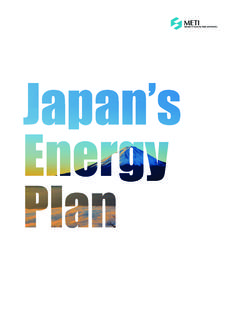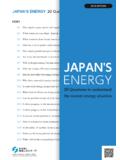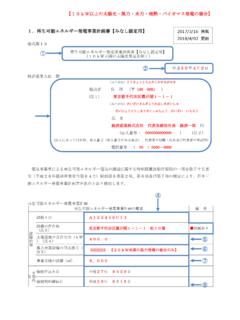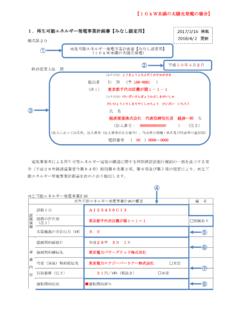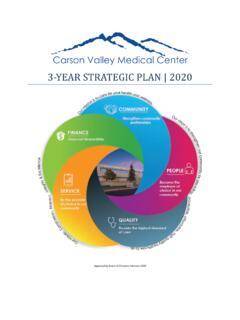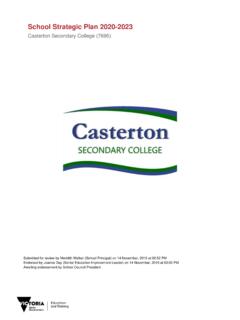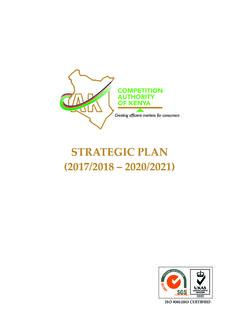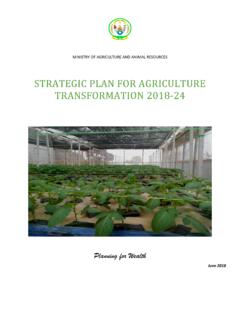Transcription of Strategic Energy Plan - METI
1 Strategic Energy plan July, 2018 Provisional Translation 1 Table of Contents Introduction 3 Chapter 1 Structural Issues, Changes in Circumstances, and Policy Timeframe Section 1. Structural issues faced by Japan 6 1. Vulnerability due to high dependency on overseas Energy resources 2. Mid- to long-term changes in the Energy demand structure (population decline, etc.) 3. Instability of resource prices (increased Energy demand in emerging countries, etc.) 4. Increasing global greenhouse gas emissions Section 2 Changes in Energy environments 9 1. Start of inter-technology competition for decarbonization 2. Geopolitical risks increased by technology changes 3. Intensified competition between nations and firms Section 3 Achievement of an optimal Energy mix by 2030 and its relation with the 2050 scenario 13 Chapter 2 Basic Policies and Measures towards 2030 Section 1 Basic policies 15 1.
2 Confirmation of the basic viewpoint of the Energy policy (3E + S) 2. Building of a multilayered and diversified flexible Energy supply-demand structure and policy direction 3. Position of each Energy source in the primary Energy structure and its policy direction of the secondary Energy structure Section 2 Policy measures towards 2030 30 1. Promotion of securing of resources 2. Realization of a thorough Energy efficient society 3. Efforts for the utilization of renewable Energy as the major power source 4. Re-establishment of the nuclear Energy policy 5. Efficient and stable use of fossil fuel 6. Fundamental reinforcement of measures for realizing a hydrogen society 7. Promotion of Energy system reform 8. Enhancment of resilience of the domestic Energy supply networks 9. Improvement of the secondary Energy structure 10. Development of Energy industry policy 11. International Energy cooperation Section 3 Promotion of technology development 108 1.
3 Formulation of plans and roadmaps for Energy -related technology development 2. Technical challenges to be addressed Section 4 Enhancement of communication with all levels of the society 112 1. Deeping of understanding of all levels of the society 2. Transparent policy planning process and enhancement of two-way communication Chapter 3 Efforts for Energy Transitions and Decarbnization towards 2050 Section 1 Ambitious multiple track scenario - Pursue every option 115 Section 2 Designing of the 2050 scenario 118 3E+S 2 2. Scientific review mechanism 3. Cost/risk verification and dynamism among decarbonizing Energy systems Section 3 Issues faced by each option and priorities in response thereto 122 Section 4 All-out efforts to realize the scenario 126 Conclusion 130 3 Introduction In response to the March 2011 Great East Japan Earthquake and accident at Tokyo Electric Power Company (TEPCO) s Fukushima Daiichi Nuclear Power Station, in April 2014 the Government of Japan established the fourth Strategic Energy plan for 2030 which stated the policies of reducing nuclear power dependency, reducing fossil resources dependency, and expanding renewable Energy .
4 Four years after the establishment of the fourth Strategic Energy plan , the time has come to not only revise the plans for 2030 but also for Japan to conceptualize its Energy choices once again, including responses focused on 2050 in response to the Paris Agreement coming into force, ultra-long-term responses in preparation for the depletion of fossil resources in the longer term, responses to changing Energy environments, etc. For that reason, the present revision of the Strategic Energy plan is comprised of realization of the long-term Energy supply and demand outlook in 2030 (July 2015 Ministry of Economy, Trade and Industry decision; hereinafter referred to as the Energy mix ) and the design of scenarios focused on 2050. There are points that must be taken into account at all times when conceiving Energy choices. Firstly, there has consistently been no change to the position that the starting point is to take measures keeping the experience, regrets, and lessons learned of the TEPCO s Fukushima Daiichi Nuclear Power Station accident uppermost in mind.
5 We will do our utmost to achieve the reconstruction and recovery of Fukushima while reflecting on and responding to the pain felt by the people affected by the accident at TEPCO s Fukushima Daiichi Nuclear Power Station. GOJ and nuclear operators must continue to reflect on the fact that they fell into the trap of the so-called myth of safety , resulting in the failure to adequately deal with the severe accident and prevent a disaster like this. Around seven years after the disaster, approximately 24,000 people still remain subject to the evacuation order. It is essential to proceed with such measures as compensating for the damage done by the nuclear accident, implementing decontamination work, constructing an interim storage facility for radioactive waste, decommissioning damaged reactors, disposing of contaminated water and controlling damage from groundless rumors.
6 There is also a pile of other challenges related to nuclear power generation, including what to do with spent fuels and final disposal of radioactive materials. In order to address these challenges, GOJ should play a more proactive role in implementing preventive and multi-layered measures in order for the fundamental settlement of the contaminated water issue and decommissioning and the other issues related to nuclear power generation by bringing together domestic and international 4 wisdom. Japan, which has experienced the accident at TEPCO s Fukushima Daiichi Nuclear Power Station, is giving the top priority to safety regarding nuclear power when realizing the 2030 Energy mix and making its Energy choices for 2050 and is reducing its dependency on nuclear power as much as possible as it aims to expand renewable Energy . Secondly, a consistent idea regarding Energy choices since the war has been Energy independence.
7 The Energy independence policy of reducing the enormous Energy costs and changing the structure dependent on overseas Energy is an unchanging requirement. The global momentum toward decarbonization seen in the Paris Agreement coming into force overlaps with the present Energy choices. The measures for these issues lead to answers to the question of how to secure Energy after fossil resources are depleted one day. Japan, a country with advanced Energy technologies, must play a leading role in the development of decarbonized Energy . Energy technologies themselves are rare resources for securing safety, realizing Energy security and decarbonization, and strengthening competitiveness. Japan will boldly challenge itself to resolve these issues by pursuing the potential of all technological options and working on the development of those technologies through public-private cooperation. Premised on the above two points, the perspectives when realizing the 2030 Energy mix and considering the design of scenarios focused on 2050 are as follows.
8 Energy environments change moment by moment, and since the establishment of the previous plan a groundswell leading to major changes, for example a huge fall in the prices of renewable Energy globally, has been seen but at the present stage no perfect Energy sources exist. The current situation is that for renewable Energy with fluctuating output such as solar power and wind power, etc. adjustments using demand control, pumping, thermal power, etc. are necessary, and complete decarbonization is difficult using these methods alone. They become more useful when combined with electricity storage and hydrogen, but there are the issues of the increase compared to overseas of the power generation cost and the power grid constraints, etc. Nuclear power has only partially gained the trust of society, and in the context of the spread and liberalization of renewable Energy the development of nuclear power is a task for the future. With fossil resources decarbonization is possible using hydrogen conversion, but this is also still being developed.
9 There are no essential changes to the technology trends at the 2030 stage which were anticipated at the time of the establishment of the plan four years ago. Japan will start by focusing all of its efforts on the steady realization of the 2030 Energy mix. 5 On the other hand, if we look ahead to the prospects for 2050, there is the possibility of non-continuous technological innovation. Competition over the development of not only renewable Energy but also all decarbonization technologies such as electricity storage and hydrogen, nuclear power, distributed Energy systems, etc. is intensifying. Competition among nations and among companies with the aim of obtaining the initiative in Energy technologies is accelerating. Japan is not blessed with fossil resources. It is a country for which obtaining the initiative in Energy technologies is more necessary than anything else. Japan will maintain all options regarding decarbonization technologies, work their development through public-private cooperation, and lead the challenge to achieve decarbonization.
10 It will challenge itself to achieve Energy transitions and decarbonization. This is the basis of the Energy choices for 2050. Based on the above, the present Strategic Energy plan , which is the fifth plan , further strengthens measures for the steady realization of the 2030 Energy mix and sets out the challenge to achieve Energy transitions and decarbonization in 2050 as the new Energy choices. We expect that these policies and the approach taken to them will bear fruit as the behavior of the nation, industries, finance, and individual from all walks of life and will lead to the implementation of Japan s vision of the future of Energy . 6 Chapter 1 Structural Issues, Changes in Circumstances, and Policy Timeframe Section 1. Structural issues faced by Japan 1. Vulnerability due to high dependency on overseas Energy resources Japan has controlled Energy consumption through various Energy -saving efforts since the first oil shock in 1973 while improving the people s lives and industrial activity as well as shifting the industrial structure to the service industry.
